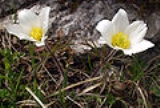
Pulsatilla alpina
Encyclopedia
Pulsatilla alpina, alpine pasqueflower, or alpine anemone is an alpine plant
found in the mountain range
s of central
and southern Europe
from central Spain
to Croatia
. It grows between 1200 m above sea level and 2700 m, and is mildly toxic.
cover.
to the easternmost Northern Calcareous Alps of Austria
, and is named after the mountain Schneeberg
. It is replaced further west by the widespread taxon P. alpina subsp. alpina. P. alpina subsp. austroalpina is found in the Southern Calcareous Alps from Switzerland
eastwards, most commonly over dolomite
. P. alpina subsp. apiifolia and P. alpina subsp. alba grow over siliceous rock, but are easily distinguished by the flower colour. Further subspecies have been named for local variants in the Cantabrian Mountains
(subsp. cantabrica) and Corsica
(subsp. cyrnea).
Alpine plant
Alpine plants are plants that grow in the alpine climate, which occurs at high elevation and above the tree line. Alpine plants grow together as a plant community in alpine tundra.-Alpine plant diversity:...
found in the mountain range
Mountain range
A mountain range is a single, large mass consisting of a succession of mountains or narrowly spaced mountain ridges, with or without peaks, closely related in position, direction, formation, and age; a component part of a mountain system or of a mountain chain...
s of central
Central Europe
Central Europe or alternatively Middle Europe is a region of the European continent lying between the variously defined areas of Eastern and Western Europe...
and southern Europe
Southern Europe
The term Southern Europe, at its most general definition, is used to mean "all countries in the south of Europe". However, the concept, at different times, has had different meanings, providing additional political, linguistic and cultural context to the definition in addition to the typical...
from central Spain
Spain
Spain , officially the Kingdom of Spain languages]] under the European Charter for Regional or Minority Languages. In each of these, Spain's official name is as follows:;;;;;;), is a country and member state of the European Union located in southwestern Europe on the Iberian Peninsula...
to Croatia
Croatia
Croatia , officially the Republic of Croatia , is a unitary democratic parliamentary republic in Europe at the crossroads of the Mitteleuropa, the Balkans, and the Mediterranean. Its capital and largest city is Zagreb. The country is divided into 20 counties and the city of Zagreb. Croatia covers ...
. It grows between 1200 m above sea level and 2700 m, and is mildly toxic.
Characteristics
Pulsatilla alpina has more upright flowers than other species of Pulsatilla, which generally have drooping flowers. They are white or, in the case of subsp. apiifolia, yellow. The flowers are produced very early, often opening while still under snowSnow
Snow is a form of precipitation within the Earth's atmosphere in the form of crystalline water ice, consisting of a multitude of snowflakes that fall from clouds. Since snow is composed of small ice particles, it is a granular material. It has an open and therefore soft structure, unless packed by...
cover.
Subspecies
A number of subspecies are recognised, based largely on the form and hairiness of the leaves. P. alpina subsp. schneebergensis is endemicEndemic (ecology)
Endemism is the ecological state of being unique to a defined geographic location, such as an island, nation or other defined zone, or habitat type; organisms that are indigenous to a place are not endemic to it if they are also found elsewhere. For example, all species of lemur are endemic to the...
to the easternmost Northern Calcareous Alps of Austria
Austria
Austria , officially the Republic of Austria , is a landlocked country of roughly 8.4 million people in Central Europe. It is bordered by the Czech Republic and Germany to the north, Slovakia and Hungary to the east, Slovenia and Italy to the south, and Switzerland and Liechtenstein to the...
, and is named after the mountain Schneeberg
Schneeberg (Alps)
The Schneeberg, with its 2076 m-high summit Klosterwappen, is the highest mountain of Lower Austria, and the easternmost 2000 m-high mountain in the Alps. It is a distinctive limestone massif with steep slopes on three sides....
. It is replaced further west by the widespread taxon P. alpina subsp. alpina. P. alpina subsp. austroalpina is found in the Southern Calcareous Alps from Switzerland
Switzerland
Switzerland name of one of the Swiss cantons. ; ; ; or ), in its full name the Swiss Confederation , is a federal republic consisting of 26 cantons, with Bern as the seat of the federal authorities. The country is situated in Western Europe,Or Central Europe depending on the definition....
eastwards, most commonly over dolomite
Dolomite
Dolomite is a carbonate mineral composed of calcium magnesium carbonate CaMg2. The term is also used to describe the sedimentary carbonate rock dolostone....
. P. alpina subsp. apiifolia and P. alpina subsp. alba grow over siliceous rock, but are easily distinguished by the flower colour. Further subspecies have been named for local variants in the Cantabrian Mountains
Cantabrian Mountains
The Cantabrian Mountains or Cantabrian Range are one of the main systems of mountain ranges in Spain.They extend for more than approximately 180 miles across northern Spain, from the western limit of the Pyrenees to the edges of the Galician Massif close to Galicia, along the coast of the...
(subsp. cantabrica) and Corsica
Corsica
Corsica is an island in the Mediterranean Sea. It is located west of Italy, southeast of the French mainland, and north of the island of Sardinia....
(subsp. cyrnea).
External links
- Pulsatilla alpina/Swiss Mountain Leader
- PlantFiles: Detailed information on Alpine Pasque-flower Pulsatilla alpina subsp. apiifolia
- Pasque flower, Pulsatilla alpina - Perennial Plants - Ranunculaceae garden
- (Pulsatilla nigricans),(Pulsatilla alpina),(Pulsatilla montana),(Рulsatilla vulgaris),(Pulsatilla patens),(Pulsatilla halleri)
- Index synonymique France PU-PZ
- N.IT. - Pulsatilla alpina subsp. austriaca P1110

